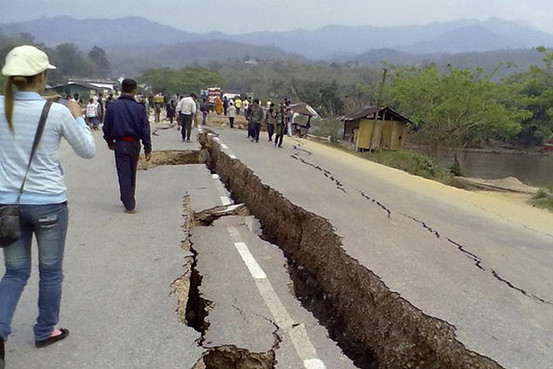Naypyidaw, Burma (WSJ): Aid agencies said they feared the death toll from a powerful earthquake in northeastern Myanmar Thursday night could climb further after government authorities reported at least 70 people were killed and hundreds of homes destroyed.
The quake struck just north of the trading hub of Tachileik, in a mountainous region near Myanmar’s border with Thailand, and was measured at 6.8 by the U.S. Geological Survey. Tremors could be felt as far off as Hanoi, nearly 400 miles away, and Bangkok, more than 450 miles away, where tall buildings swayed. There was no tsunami as the earthquake occurred far inland.
A major concern of relief agencies is that it is often hard to get reliable information about disasters until long after they occur in Myanmar, which is controlled by a secretive, military-backed government with a history of blocking foreign aid workers from roaming freely. The government in 2008 was widely criticized internationally for delaying requests for help after Cyclone Nargis rammed into the country, killing around 130,000 people.
In addition, the area most severely hit by Thursday’s earthquake is remote, and telephone signals and other communications there are unreliable.
State-run radio in Myanmar reported Friday that 74 people were confirmed killed in the earthquake, and the death toll mounted steadily through the day as more information trickled in from the rugged area. The radio reports said 390 houses and 14 Buddhist monasteries were damaged, along with nine government buildings. Officials at international aid agencies said damage to roads and other infrastructure could hamper the delivery of aid.
Recent heavy rains may also have contributed to landslides blocking some of the few roads into the area, although it is still too soon to assess the full impact of the earthquake, said one international relief agency official who asked not to be identified. Aid workers in Myanmar often request anonymity when speaking with the media, lest their comments undermine their ability to work freely in the country, which is also known as Burma.
Some of the worst damage was in the area around Tachileik. “I was in my room watching TV when the shaking began at around 8:45 pm,” said one resident, who asked not to be identified. “The TV almost fell from the stand, then I heard neighbors calling out people onto the street. Most of the townfolks spent the night outside. I’ve never felt as helpless as I did last night.”
Photographs taken by aid workers with World Vision Inc. show tarmac roads ripped and wood-framed homes shaken apart by the earthquake.

An earthquake-damaged road in Burma's northeastern Shan State. (Photo: Democratic Voice of Burma, Alinyaung/Associated Press)
Across the border in Thailand, one woman in the town of Mae Sai by the earthquake when a wall fell on her as she fled her home. Kindergarten teacher Naiyana Yakas, 35 years old, said the earthquake was strongest she had ever experienced and that she spent much of the evening outside with colleagues and neighbors, waiting for aftershocks.
“We were afraid it was going to be like Japan,” she said, referring to the March 11 quake that struck off Japan’s northeastern coast.
Wisit Sittisombat, the district chief in Mae Sai, said aftershocks continued Friday but reduced in intensity. “Many taller buildings have structural cracks, including apartments for government staff and hospital works,” Mr. Wisit said. “But otherwise everything is back to normal.”























